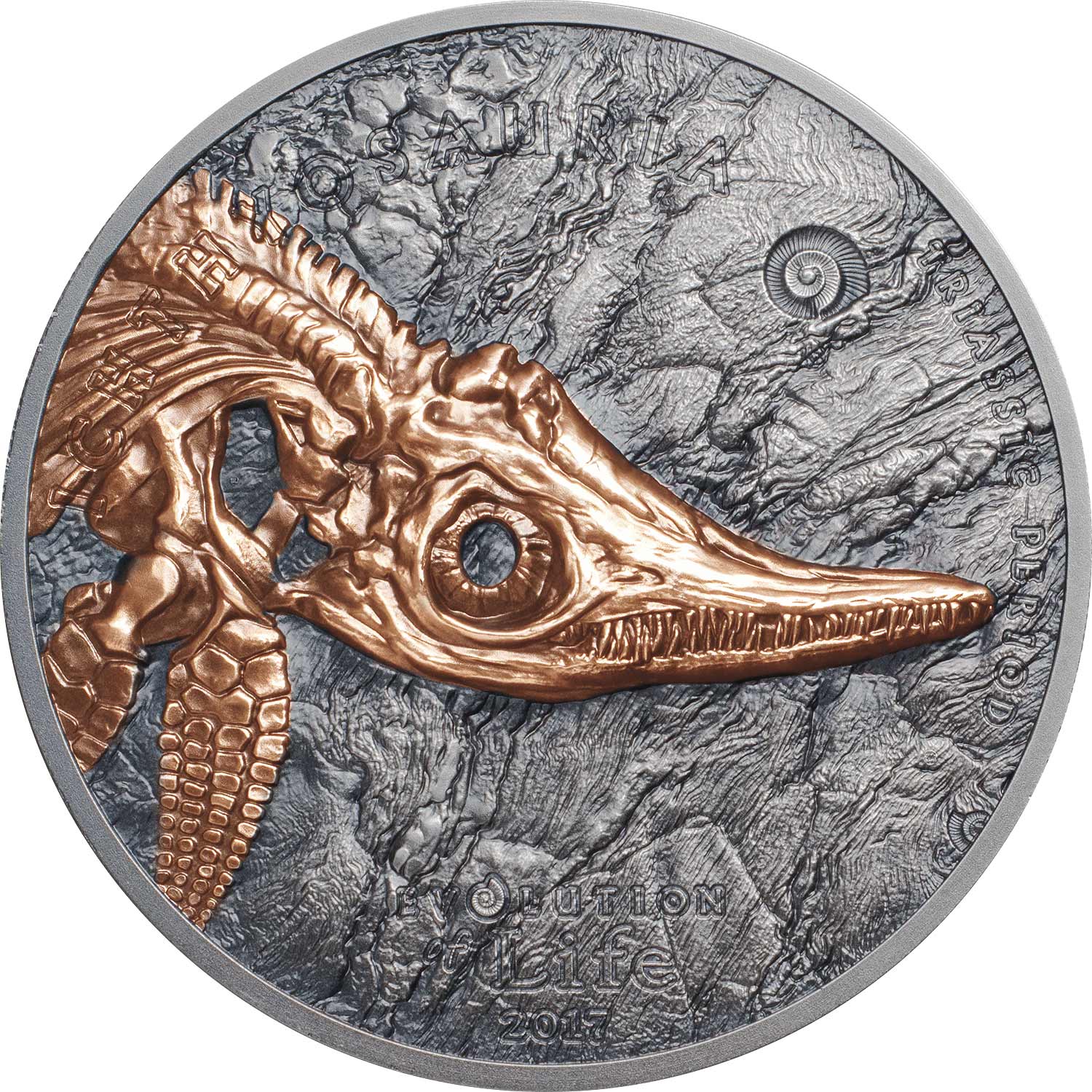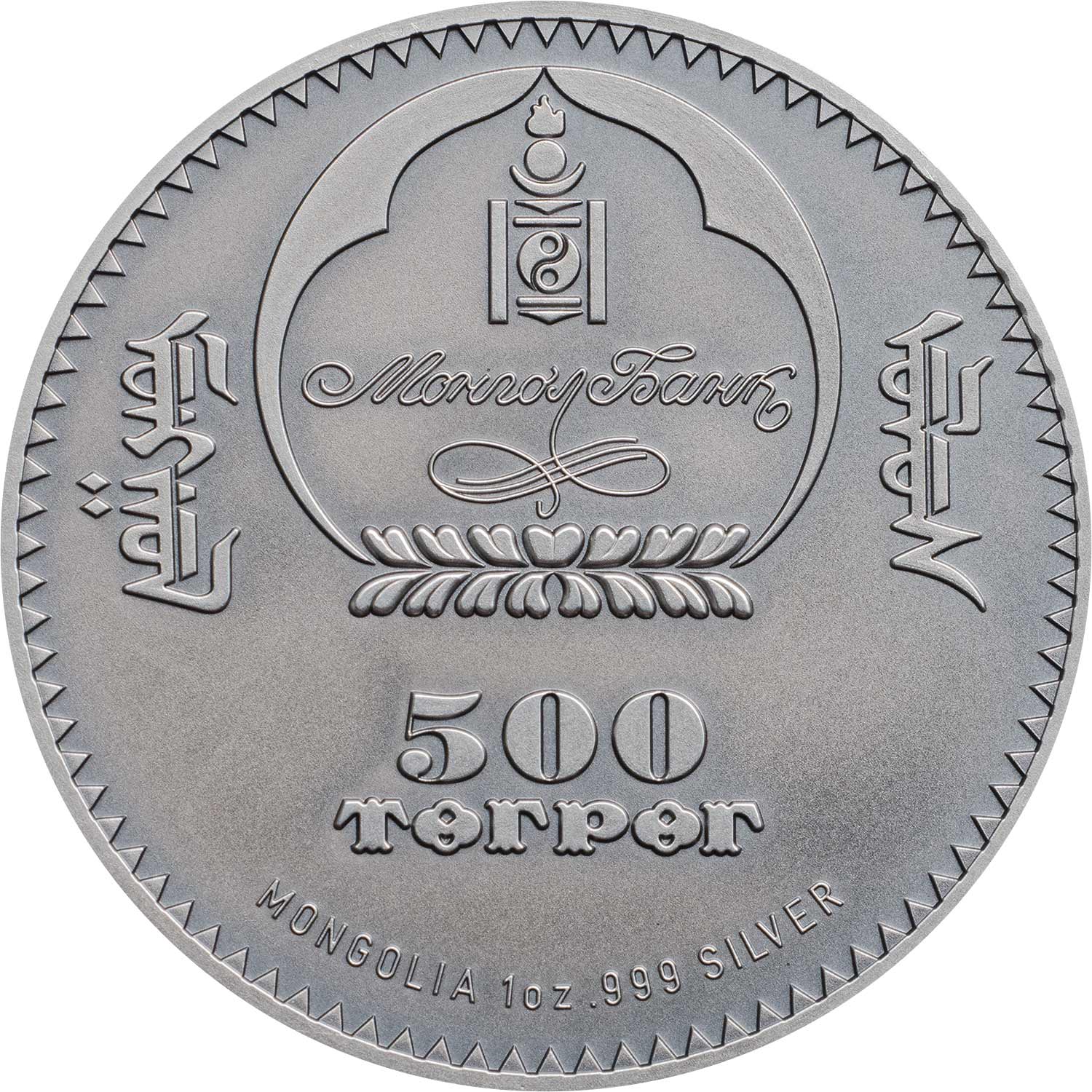CIT’s brilliant Evolution of Life series debuts its third coin, the aquatic reptile Ichthyosaurus
Quickly establishing itself as one of CIT’s finest and most popular series. Evolution of Life launched at the ANA show in 2015 with a beautiful coin depicting an ammonite. Following last year was an equally attractive Trilobite coin. As with life itself, the creature on this third coin is bigger and tougher, moving from the invertebrate to the world of reptiles; marine in this case.
The ichthyosaur is a marine reptile superficially similar to modern dolphins rather than the long-necked pleisiosaurs more commonly known, and could reach sizes well in excess of a dozen metres. Fitting a good representation of a fossil of one of these on a coin was never going to be easy, but CIT have done an excellent job all the same.
Depicting the head and front appendage area of a specimen, the coin continues the past trend with fine detail and a well realised rock-bed background, itself holding a small ammonite impression. As before, the main fossil is picked out in rose-gilding and the rest of the coin is finished in black to mimic rock. There are several inscriptions present, but they’re exceptionally well integrated, even being gilded to match the fossil where they cross paths. The obverse is a standard one for Mongolia, the emblem and accompanying inscriptions.
Packaging is the usual CIT wooden box with a customised image on top. A good quality item that also holds the certificate of authenticity. Mintage is limited to 999 pieces and these tend to be very popular. Also coming is one of CIT’s ubiquitous minigold variants. Similar artwork struck into a half-gram, 11 mm gold coin, CIT have been producing these for years, obviously with good results. They come with a certificate but no box and have a mintage of 15,000.
MINTS DESCRIPTION: New issues of the Evolution of Life collection are one of the most anticipated CIT coins at the yearly ANA show. The astonishing and detailed high relief fossils, plated in rose gold and set in an antique fnish matrix, have garnered a huge following among coin collectors.
After lingering in the Paleozoic Era for two years, the series now presents the Ichthyosaur of the Mesozoic Era – the Age of Reptiles. The Ichthyosaur fossil is covered in rose-gold while the smartminting© relief accentuates the bony scleral eye ring and pointy teeth of this Triassic predator.
Ichthyosaurs were marine reptiles that lived 250 to 90 million years ago. The various species resembled modern dolphins by convergent evolution or the development of similar traits in similar environments.
Ichthyosaurs (Greek for “fish lizard”) are large marine reptiles. Ichthyosaurs belong to the order known as Ichthyosauria or Ichthyopterygia (‘fish flippers’ – a designation introduced by Sir Richard Owen in 1840).
Ichthyosaurs thrived during much of the Mesozoic era; based on fossil evidence, they first appeared approximately 250 million years ago (mya) and at least one species survived until about 90 mya, into the Late Cretaceous. During the early Triassic Period, ichthyosaurs evolved from a group of unidentified land reptiles that returned to the sea, in a development parallel to that of the ancestors of modern-day dolphins and whales, which they gradually came to resemble in a case of convergent evolution. They were particularly abundant in the later Triassic and early Jurassic Period, until they were replaced as the top aquatic predators by another marine reptilian group, the Plesiosauria, in the later Jurassic and Cretaceous Period. In the Late Cretaceous, ichthyosaurs became extinct for unknown reasons.
Science became aware of the existence of ichthyosaurs during the early nineteenth century when the first complete skeletons were found in England. In 1834, the order Ichthyosauria was named. Later that century, many excellently preserved ichthyosaur fossils were discovered in Germany, including soft tissue remains. Since the late twentieth century, there has been a revived interest in the group leading to an increased number of named ichthyosaurs from all continents, over fifty valid genera being now known.
Ichthyosaur species varied from one to over sixteen metres in length. Ichthyosaurs resembled both modern fish and dolphins. Their limbs had been fully transformed into flippers, which sometimes contained a very large number of digits and phalanges. At least some species possessed a dorsal fin. Their heads were pointed, the jaws often equipped with conical teeth to catch smaller prey. Some species had larger bladed teeth to attack large animals. The eyes were very large, probably for deep diving. The neck was short and later species had a rather stiff trunk. These also had a more vertical tail fin, used for a powerful propulsive stroke. The vertebral column, made of simplified disc-like vertebrae, continued into the lower lobe of the tail fin. Ichthyosaurs were air-breathing, bore live young, and were probably warm-blooded. (Source: Wikipedia)
SPECIFICATION
| NAME | 2017 SILVER | 2017 MINIGOLD |
| DENOMINATION | 500 Togrog | 1,000 Togrog |
| COMPOSITION | 0.999 silver | 0.9999 gold |
| WEIGHT | 31.1 grams | 0.5 g |
| DIAMETER | 38.61 mm | 11.00 mm |
| FINISH | Antique | Proof |
| MODIFICATIONS | Rose-gold gilding | None |
| MINTAGE | 999 | 15,000 |
| BOX / COA | Yes / Yes | No / Yes |







Leave A Comment